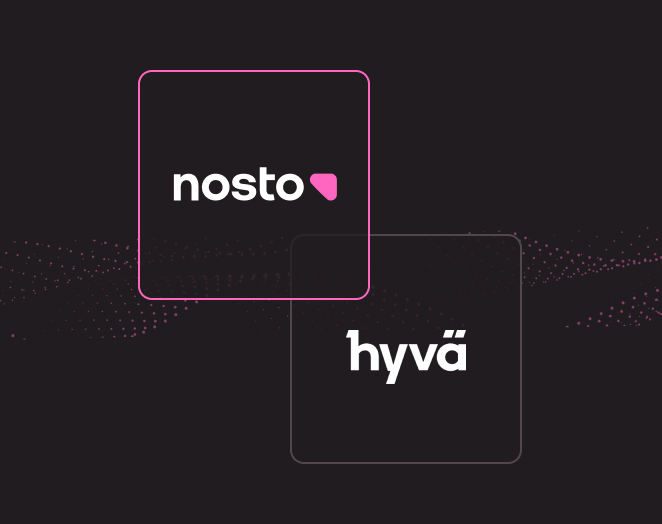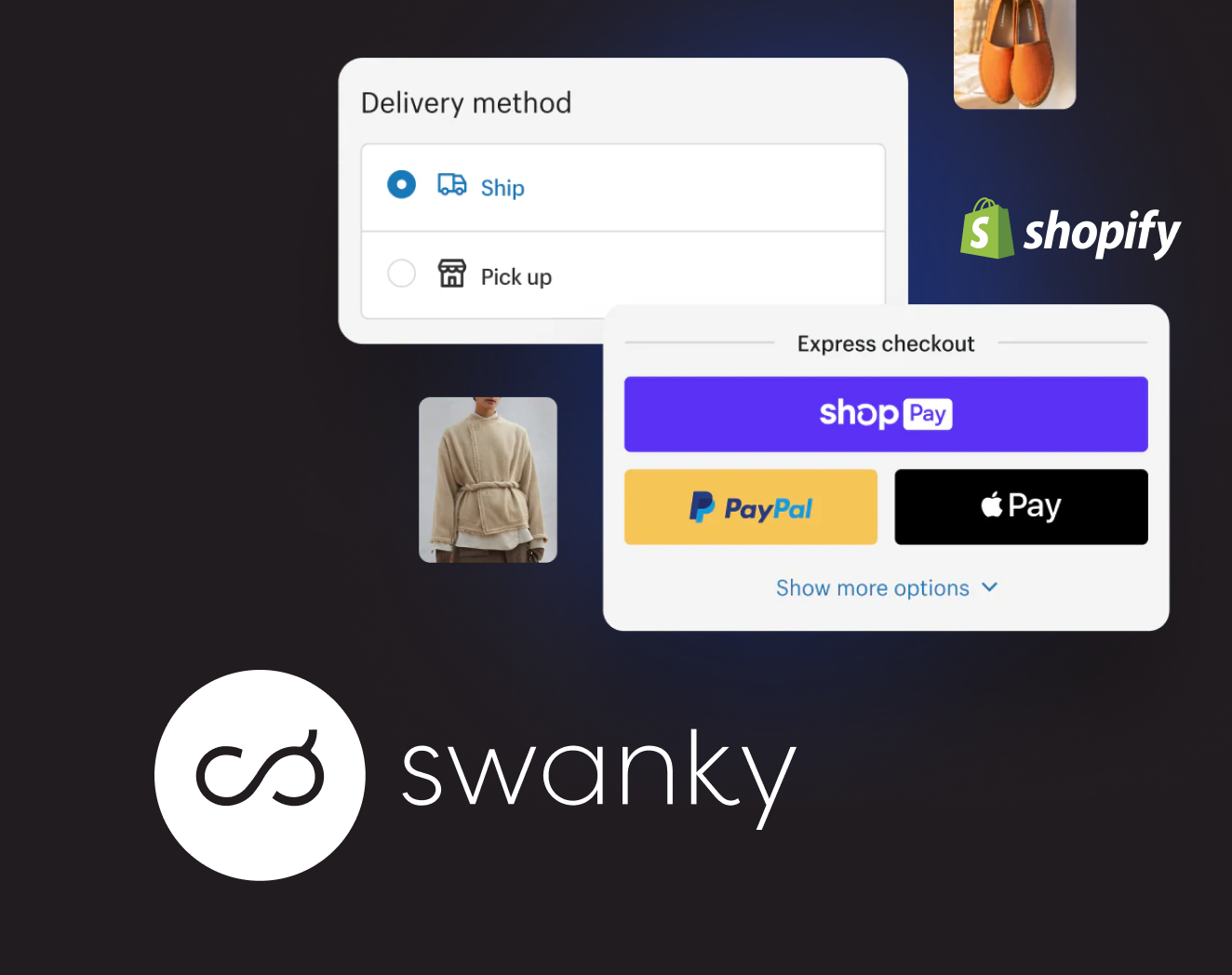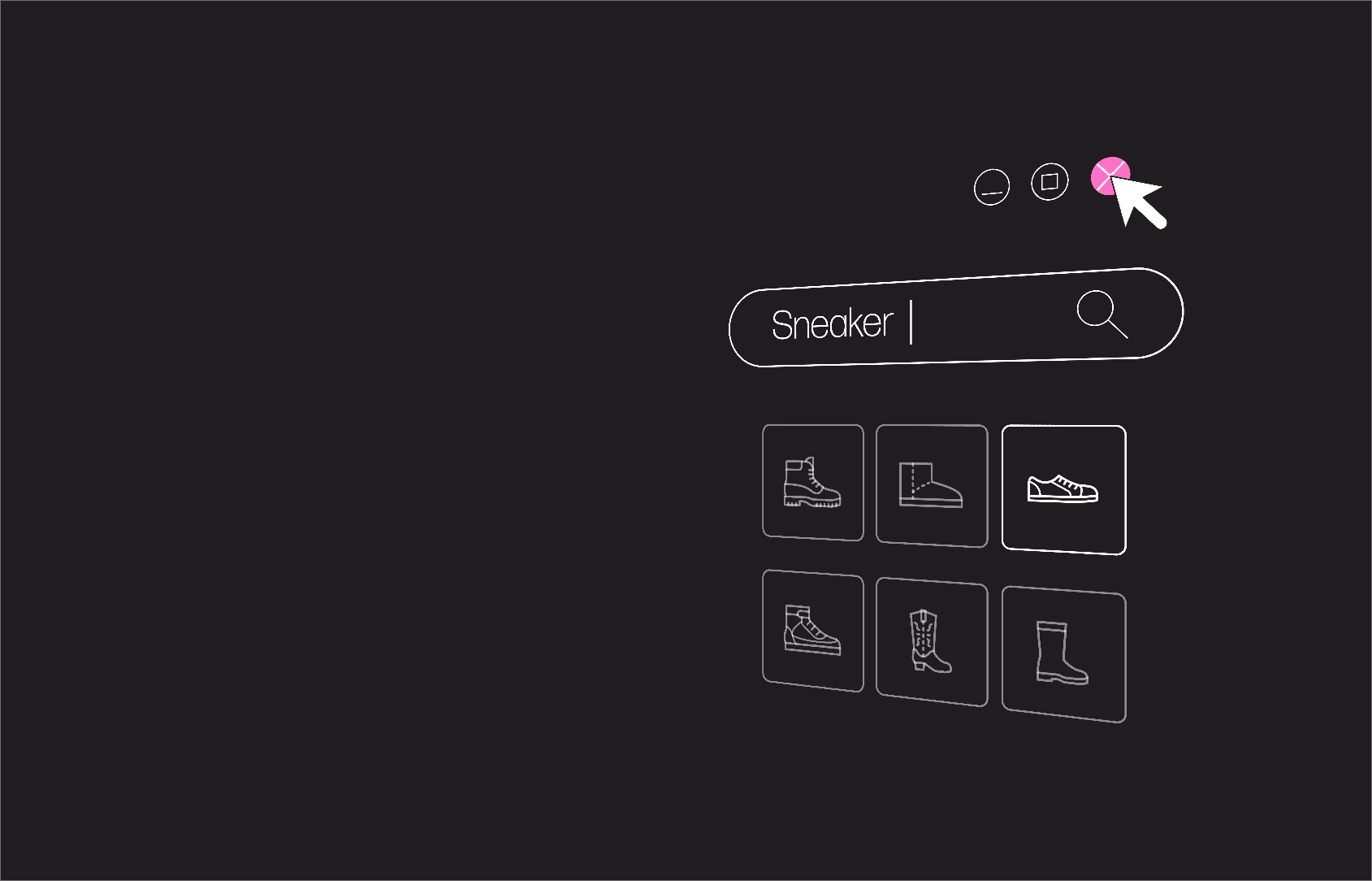43 Product Recommendation Examples That Transform the Ecommerce Experience
Use these product recommendation examples to inspire your ecommerce store and email marketing strategies to increase relevance and revenue.
Personalized product recommendations are an integral part of any successful retailer’s ecommerce strategy, helping customers discover products that are most relevant to their interests and reduce barriers to purchase.
But that’s not all they’re meant to do.
When used efficiently, product recommendations can completely transform customer interactions, creating a fluid and consistent experience that leads to more conversions, higher order value, and an overall greater trust in your brand.
Explore these product recommendation examples you can use across your ecommerce store and email marketing efforts.
1. Homepage
Why the homepage? While not always the first touchpoint for shoppers, the homepage is still considered an important welcoming point for first-time visitors who know little about your brand (and, similarly, a place for you to learn more about them as they interact with your site). This welcome experience is the key to capturing attention and should be relevant to the different shoppers, channels, and entry points to the site.
New visitors are obviously more of a challenge to gauge since you’ve yet to collect any behavioral data from them. In this case, product recommendations best practices call for highlighting items with the highest conversion rates (i.e. top sellers).
DVF’s homepage has a sleek design with a hover effect showing a product from different angles. More than just aesthetics, the homepage is strategically designed to encourage product discovery from the moment shoppers land, eliminating unnecessary navigation and keeping the focus on their stunning collections.
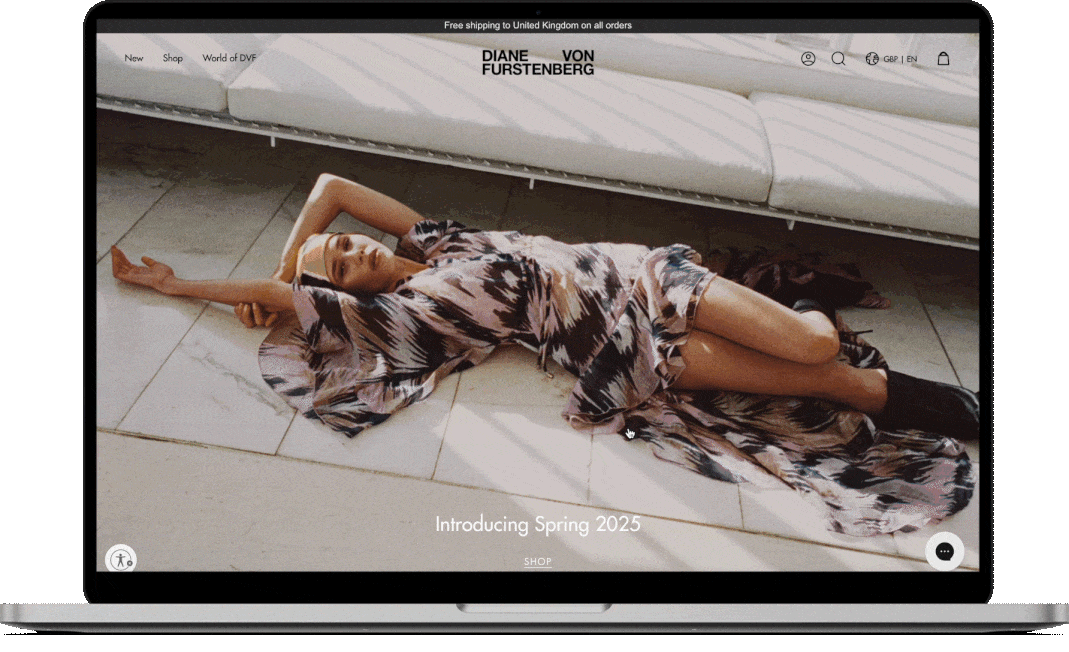
Using data from previously viewed items, Jaded London serves up tailored suggestions for returning visitors showcasing previously viewed as soon as a shopper lands back on their homepage.
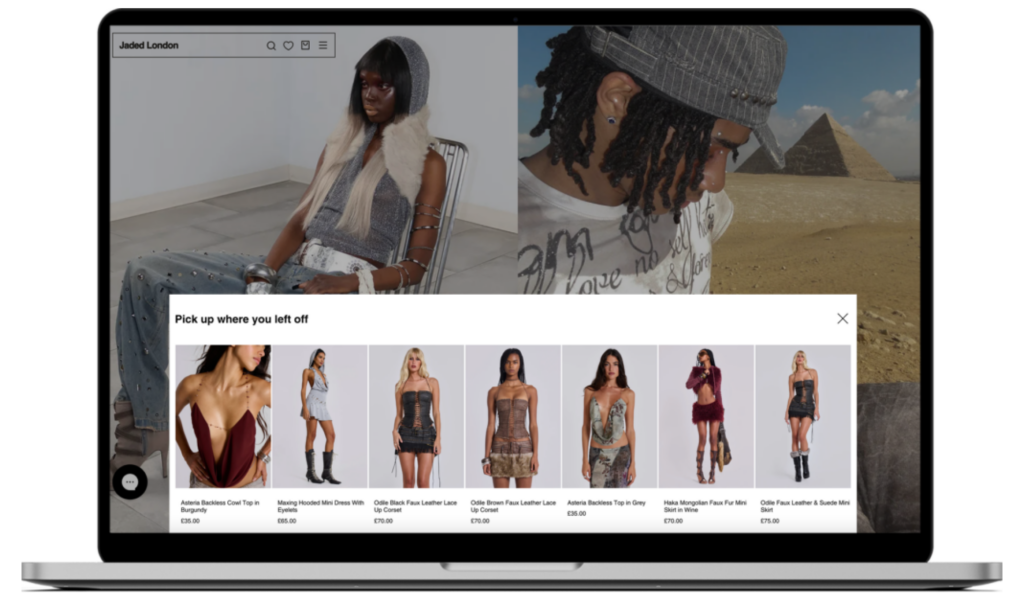
By leveraging location-based data, Brochu Walker brings a personalized touch to online shopping with its “Most Loved in Your Area” product recommendations, making shoppers feel like they’re part of an exclusive, local fashion community.
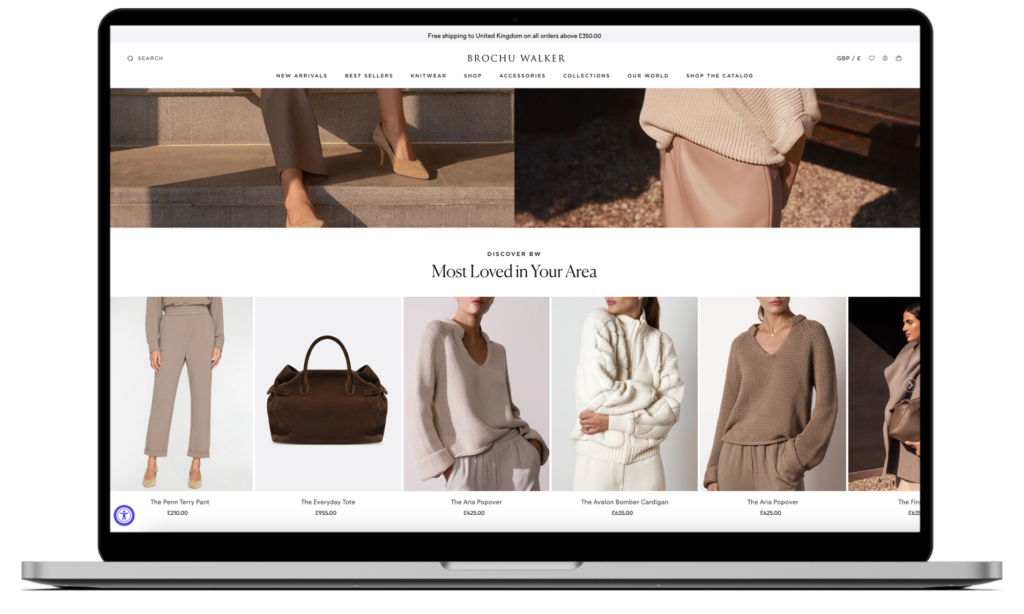
Footkorner implemented a homepage brand affinity product recommendation banner that shows Nike products to those they’ve established as having an affinity to the Nike brand.
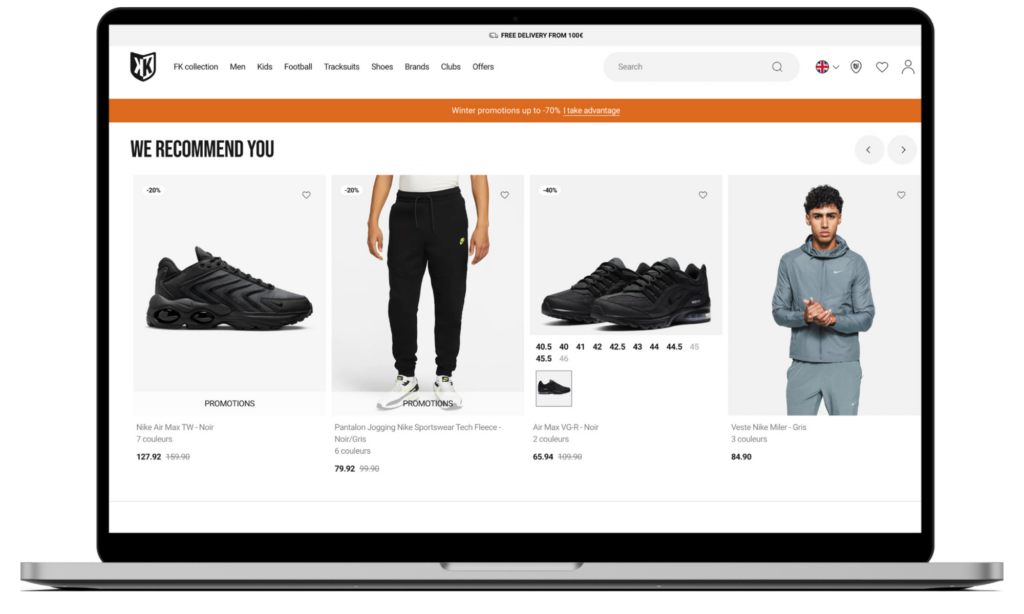
Beauty giant Sephora features a ‘Chosen For You’ tag:
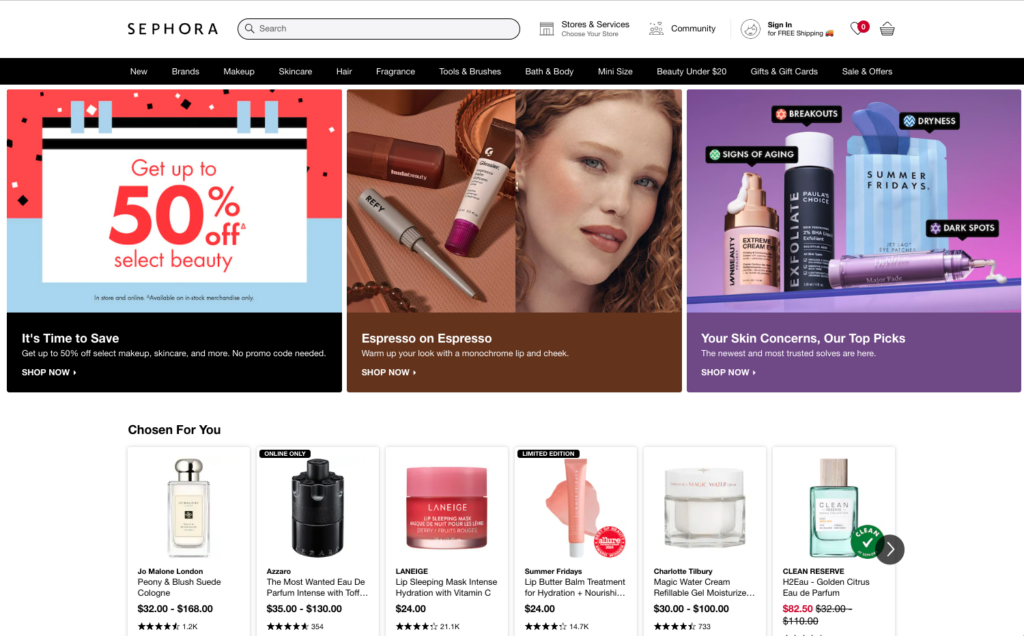
As we know, shoppers are highly susceptible to influence from their peers (one of the many truths in the psychology of ecommerce). The items that other shoppers are browsing and purchasing are desirable and so, recommendations that hint at what other visitors are also interested in have proven to increase conversion and click-through rate.
2. Product Detail Pages
Why product detail pages? Visitors who land on a product page are still searching for something to buy. While they browse, offer relevant alternatives and complementary products that pique their interest – otherwise known as up-selling and cross-selling, respectively.
Show Me Your Mumu use a “You May Also Like” personalized product recommendation to the wedding line PDPs, offering shoppers alternative styles in the same color-way as the currently-viewed product.
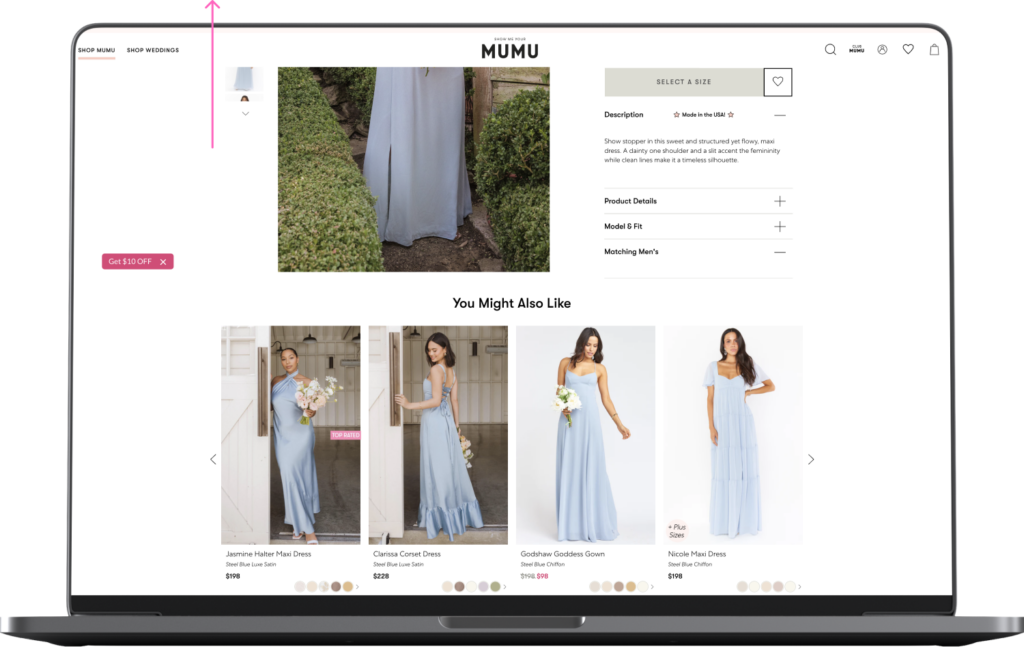
Diane Von Furstenberg uses product recommendations directly within product pages that highlight visually similar products to those currently viewed.
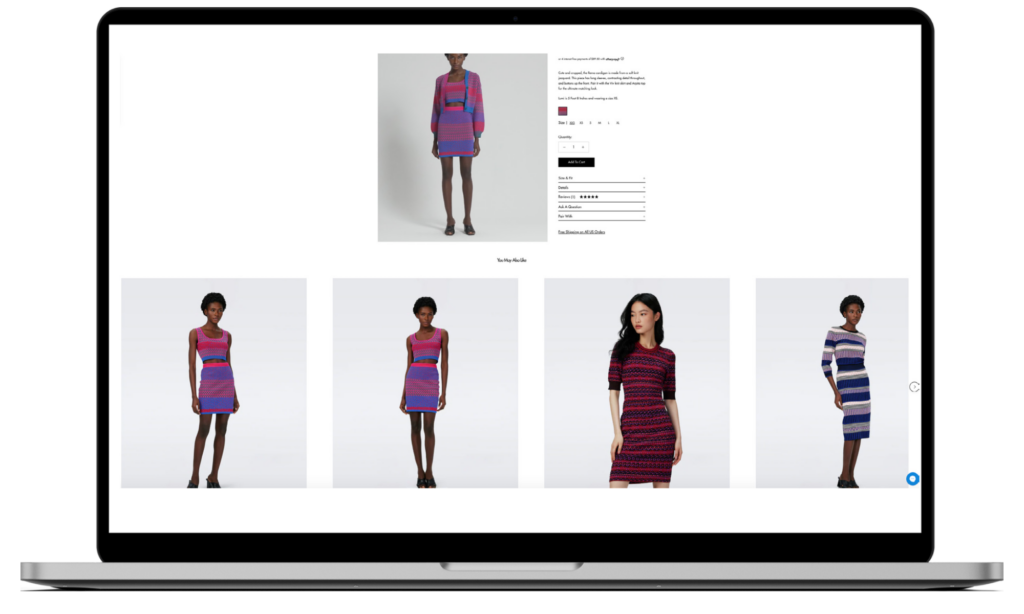
Nosto’s Dynamic Bundles stepped in to take the place of the in-store product expert, dynamically recommending complementary products from set categories to go with the currently viewed product so that Dermalogica‘s shopper could ‘complete their regimen.’
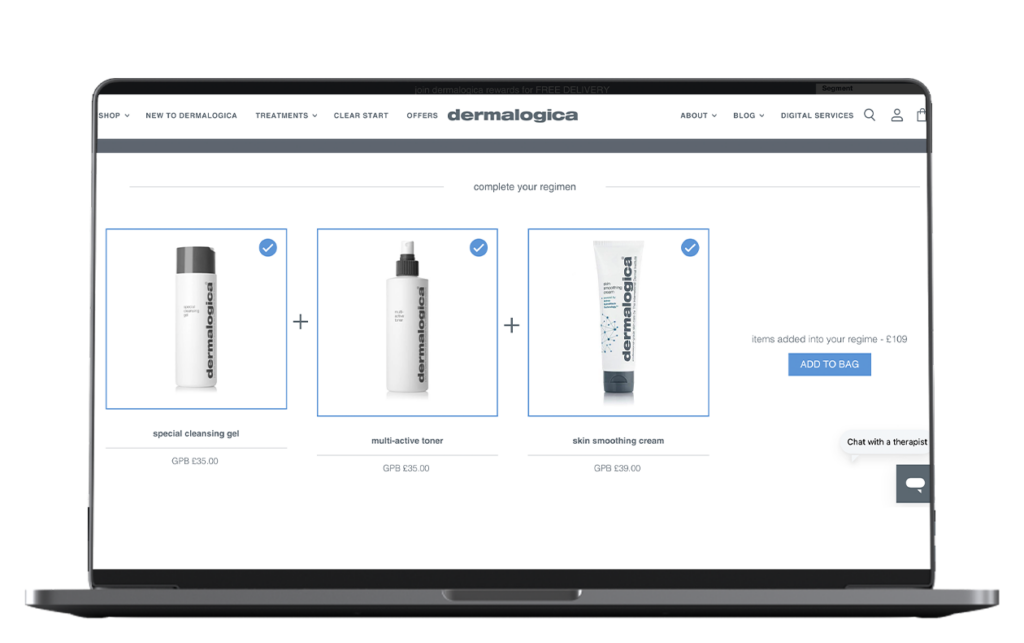
A clever way to catch the shopper’s eye with product page recommendations is to display a ‘FOMO’ ribbon to show the product will soon be out of stock:
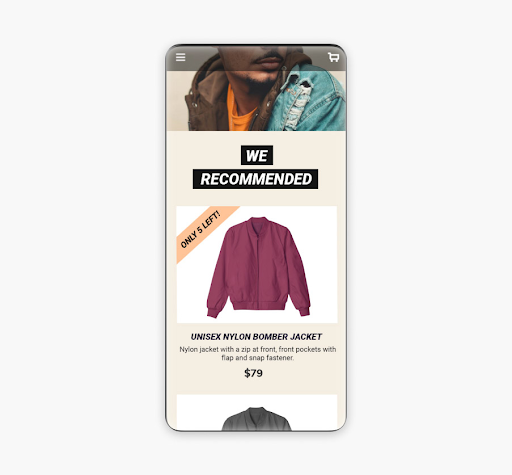
Aubade takes cross-selling to the next level with its “Complete Your Set” bundle. By using smart filters, the brand helps shoppers find the perfect matching pieces.
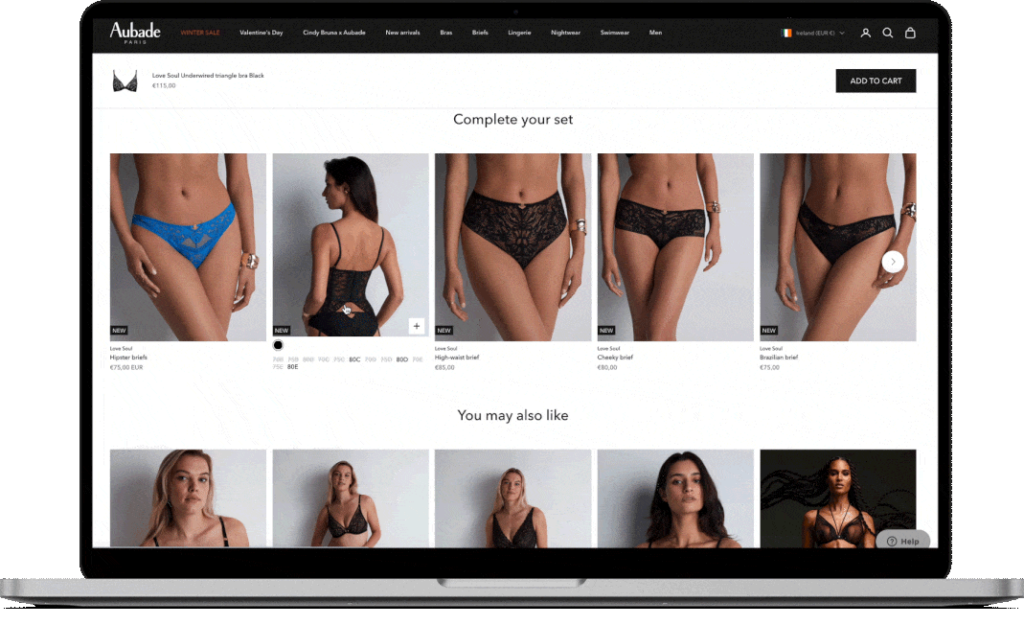
Cynthia Rowley keeps similar products in front of the shopper by displaying ‘You may also like’ product recommendations:

Combine 2 product recommendation blocks on product detail pages to maximize the experience. In this example, products that typically bought with the one currently viewed are shown above products that the customer has previously browsed:
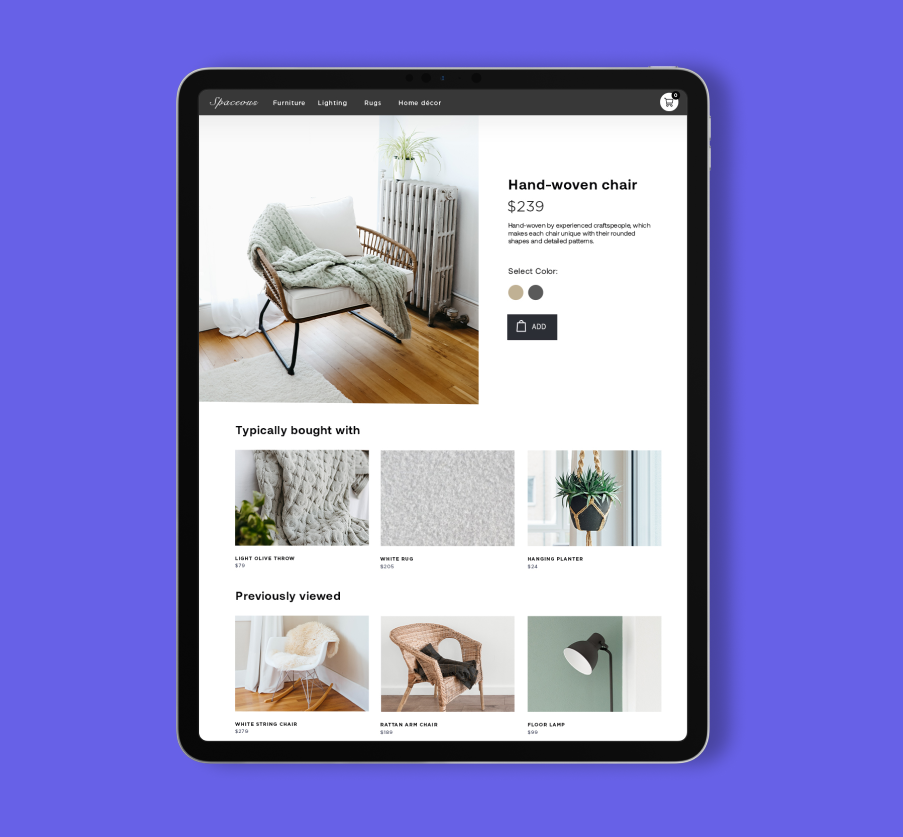
Here’s another example of this tactic for the sportswear industry:
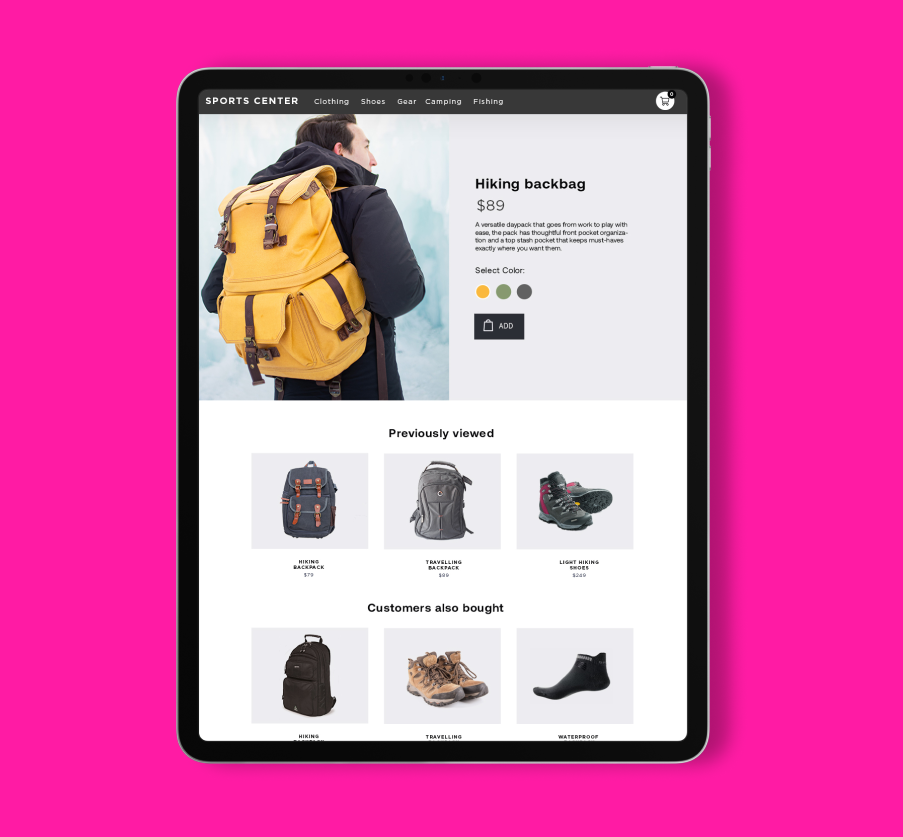
Image ribbons on pages can launch a shoppable user-generated content banner, as seen here on Gymshark’s product page:
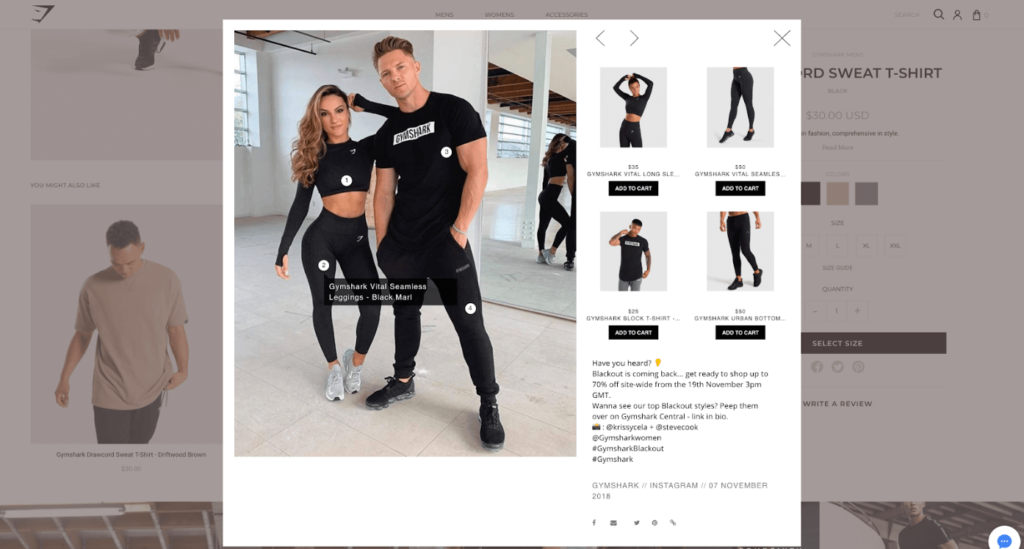
The Sports Edit and their merchandisers know that some ranges are always a perfect match for each other. By tagging ranges such as “workout tops” and “tights” together, they ensure that key inventories are always matched:
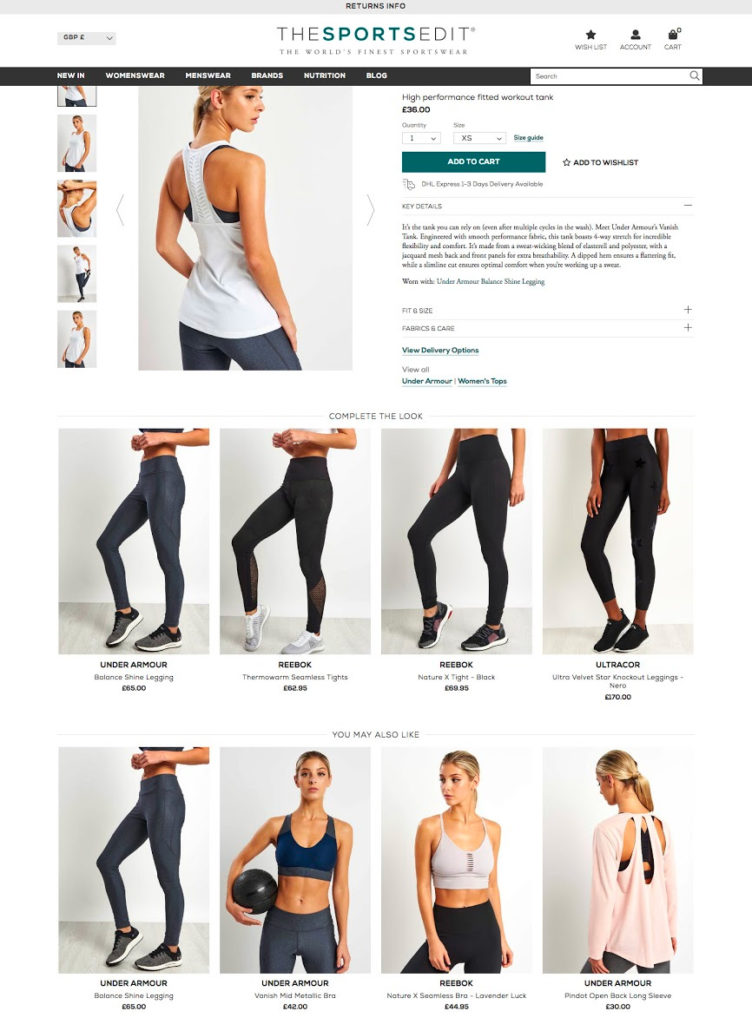
3. Search Pages
Anticipating what your customer is searching for is the cherry on the sundae of personalized shopping. The ideal search page incorporates intelligent recommendations–items that other customers have viewed and purchased to guide customers along their journey. The fun part? Intelligent recommendations are also grammar gurus and can spot incorrect search terms, instead displaying items similar to that term. For maximum ease-of-use, search recommendations should be displayed above the fold so customers can easily find what they’re searching for.
In this example, product recommendations are shown complementary to the search term ‘headphones’:
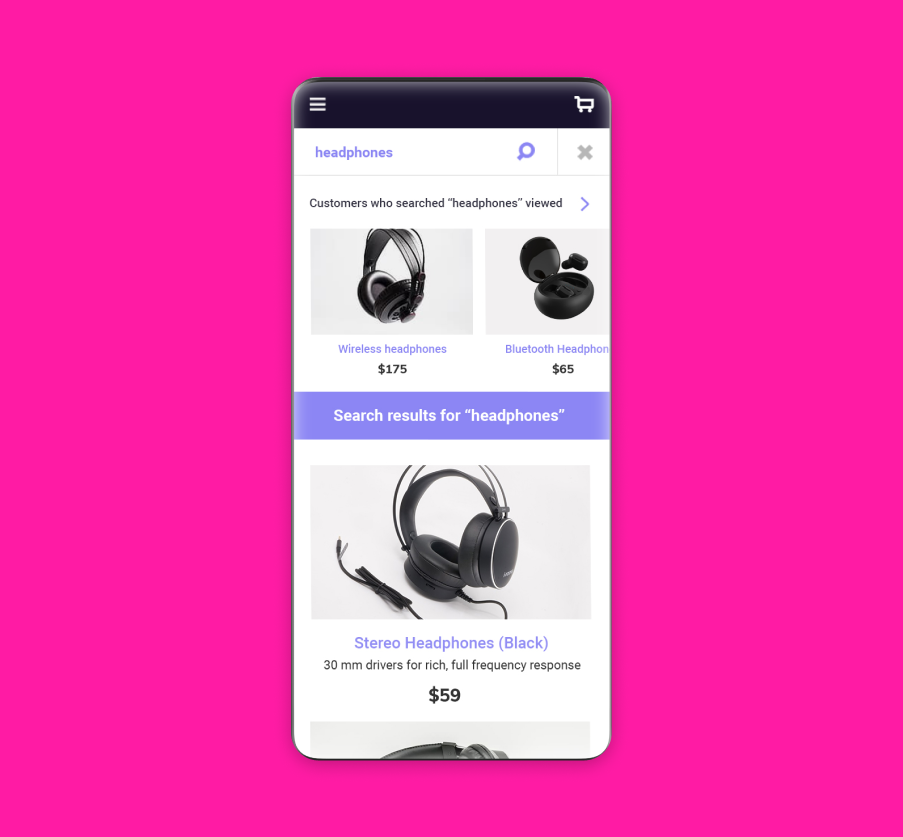
Boody uses the high intent of using the search bar to showcase a ‘popular products’ block before shoppers even start typing.
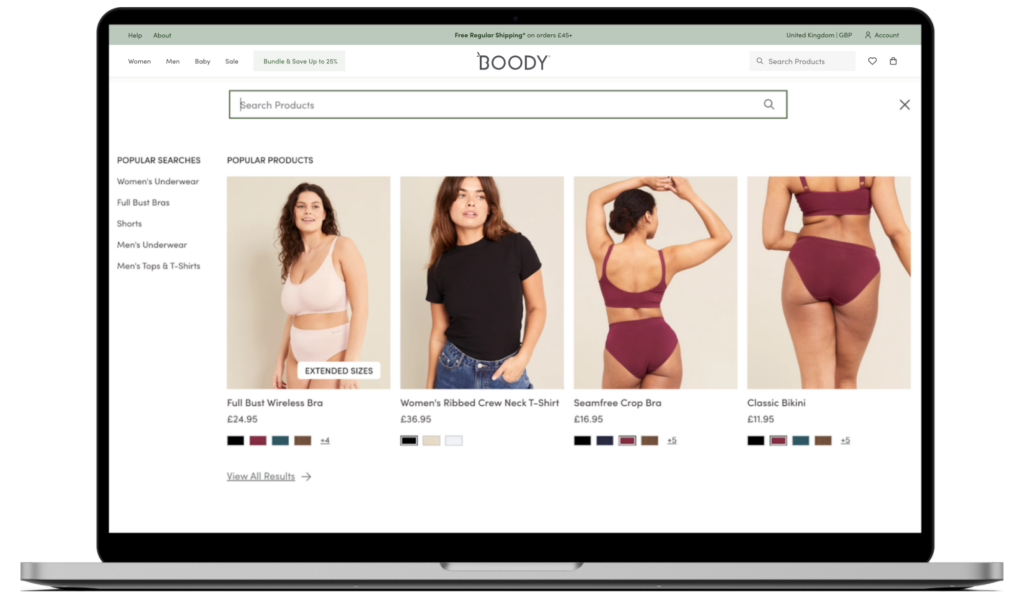
Puravida’s search page recommendations are displayed at the top of the page, also including product ratings to drive more interest:
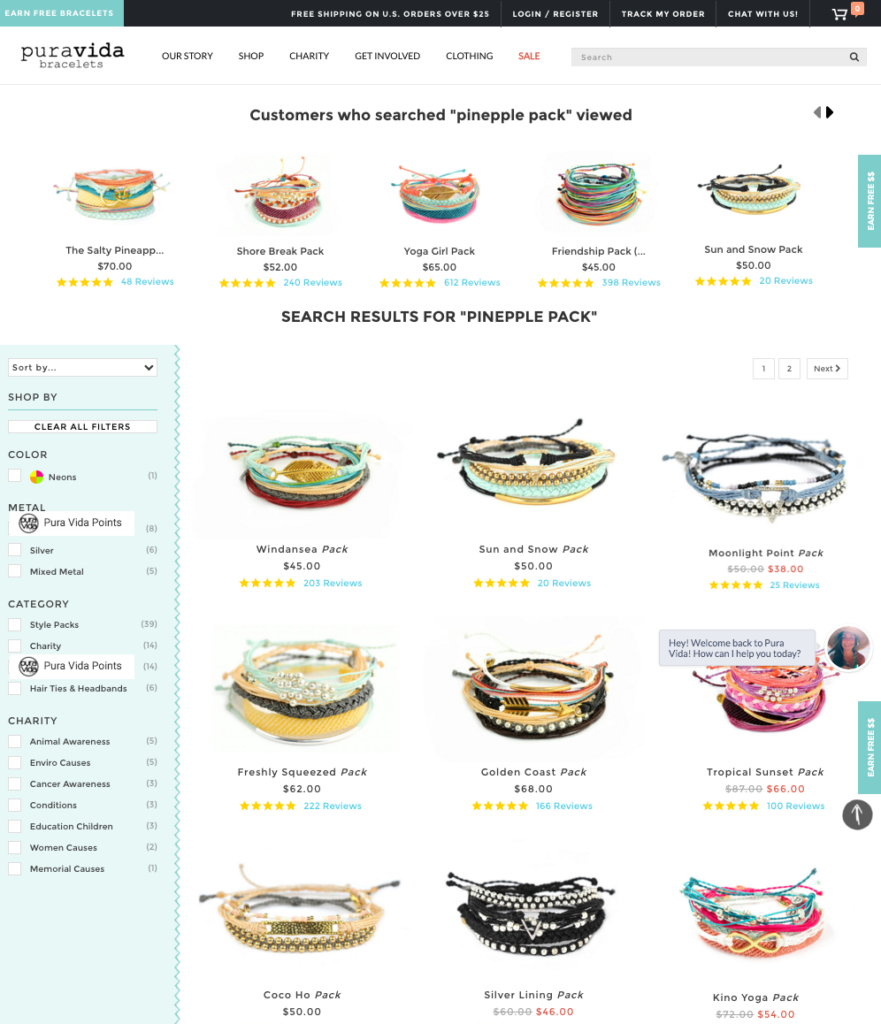
Stockholm-based streetwear store Caliroots’ search engine showcases contextually relevant products; for example, an in-store search with the keyword “Mike” presents skateboards done in collaboration with Kodak Mike Carroll and Kodak Mikemo.
The behavioral “Search and Viewed” recommendation element below the actual search results reveals that users who searched for ‘Mike’ ended up viewing ‘Nike’ sneakers:
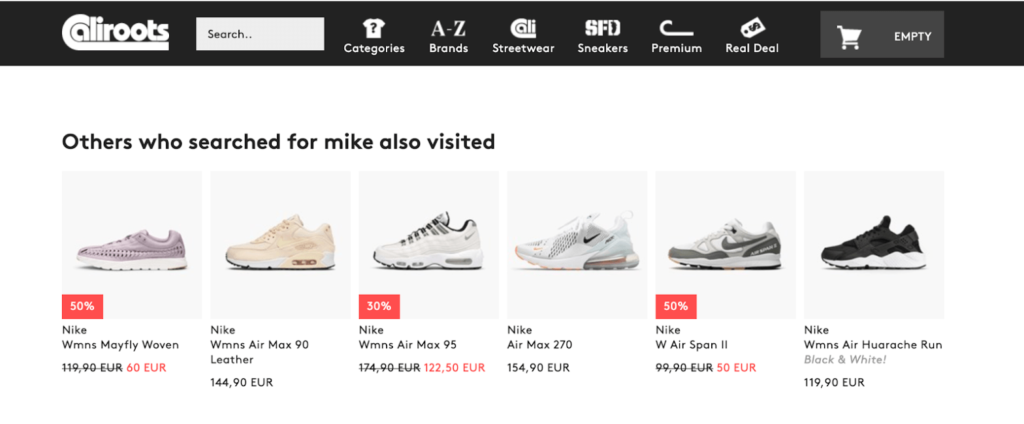
On award-winning UK retailer Designer Childrenswear’s search page, Armani is heavily represented on the site. Upon searching for “Armani”, a shopper gets redirected to the brand page with the relevant faceting options to further narrow down the selection:
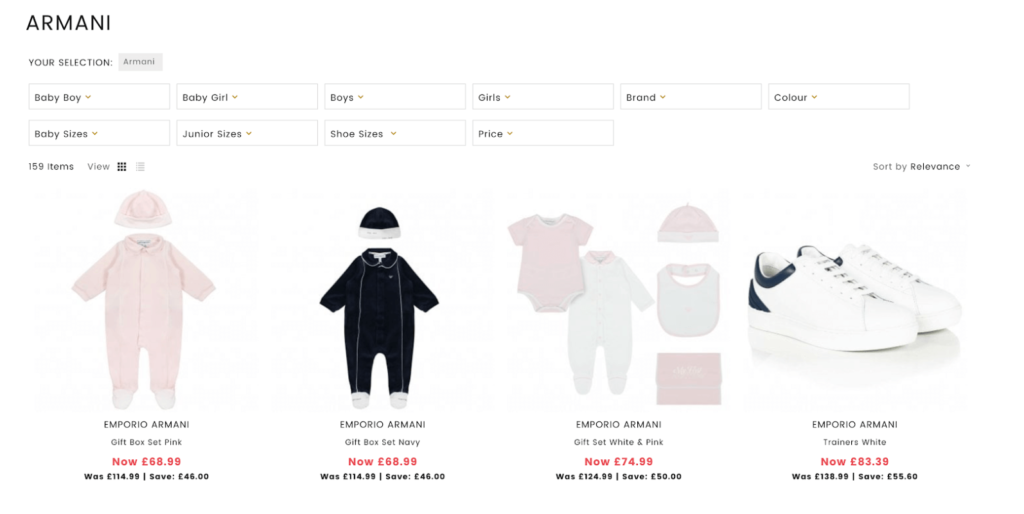
4. Category Pages and Product Listing Pages
Category pages are one of the most important drivers of discovery in an online store. They store all of the relevant products and expose them on a dedicated page, allowing the shopper to narrow down to a particular subcategory to find exactly what they are looking for.
To further streamline product discovery, Casio also uses Nosto’s Product Recommendations across their Casio and G-Shock sites.
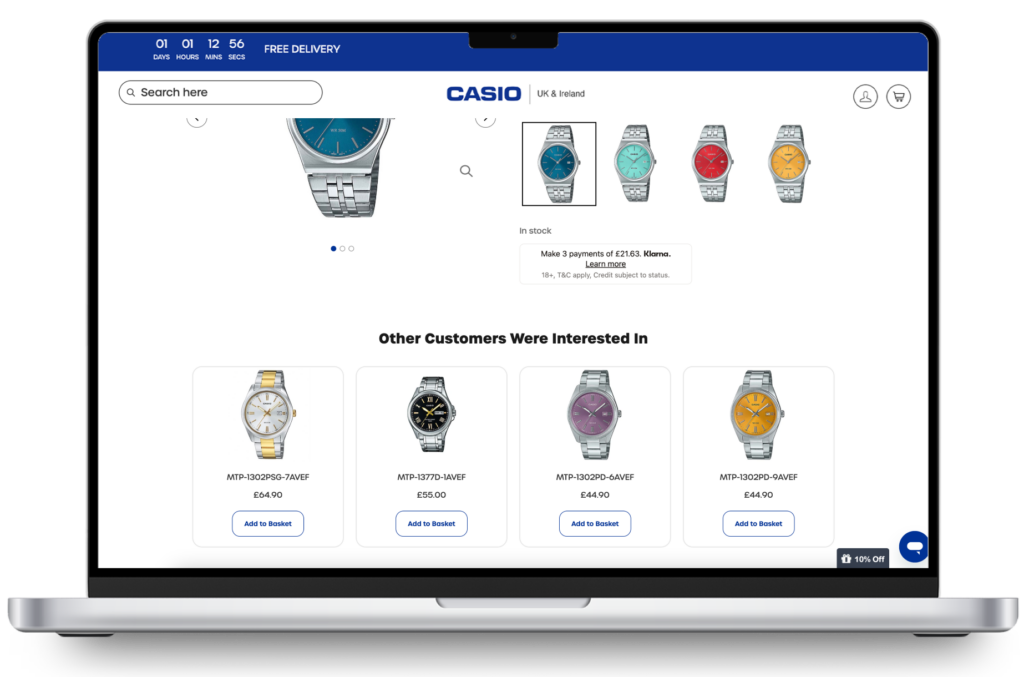
The WOD Life use product recommendations on their category page to help visitors easily find popular products in a specific category. To do so, they added a product recommendation block ‘Most popular in this category’ at the bottom of the category page.

New Zealand fashion house Augustine showcases a top-level category for bottoms, which includes skirts, shorts, pants, and a similar setup of Browsing History related recommendations (with a fallback to Best-seller recommendations if the shopper is a first-time visitor):
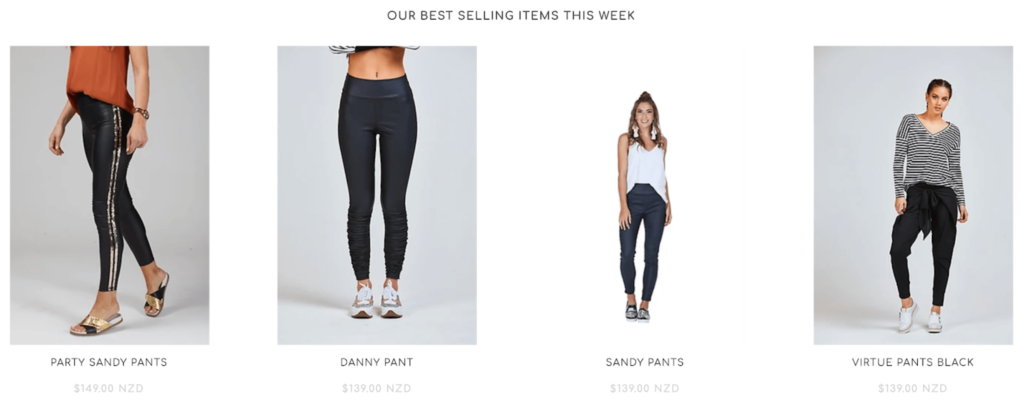
5. Shopping Cart Page
Why the cart page? This page is prime time for up-selling. It’s the perfect moment to offer complimentary items to complete a customer’s purchase. Add in some product recommendations on this page to remind your customer about the most relevant items browsed. Fun fact: up to 25% of customers who click on these recommendations actually order the item (just make sure to exclude items already in their cart).
Buffalo Jeans has created a a hovering product recommendation that is scrollable allowing shoppers to easily add products into the cart.
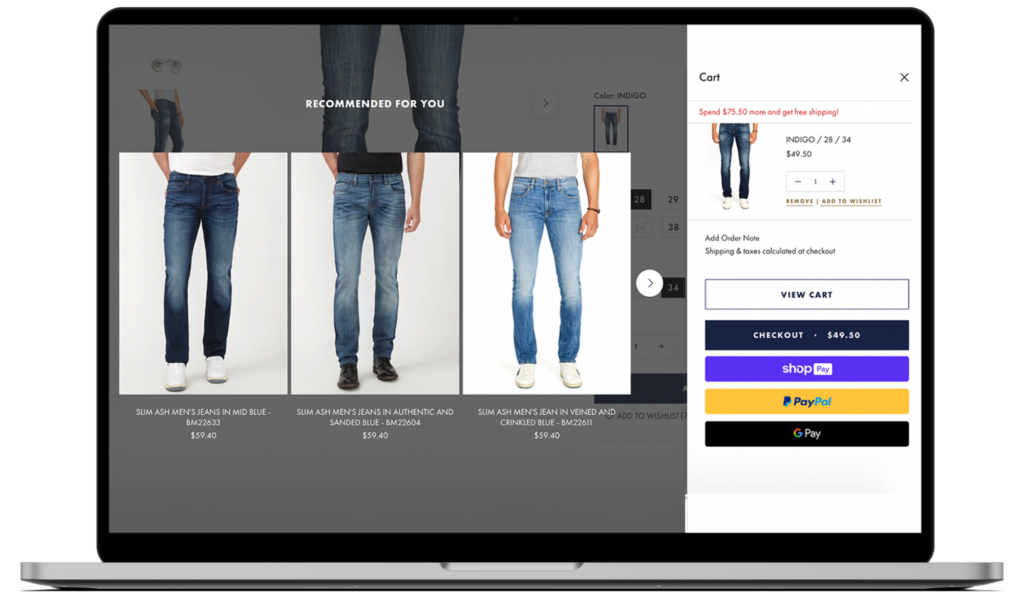
Free shipping incentives are also an effective way to push product recommendations. And, if you offer free delivery above a certain spend value, it helps customers reach that minimum value by offering products to add to their cart. This will surely up your customer service game. In the below example, Nest New York shoppers can add free perfume samples during checkout to leave a lasting impression. There’s also a free shipping threshold bar at the top of the cart drawer to increase Average Order Value (AOV).
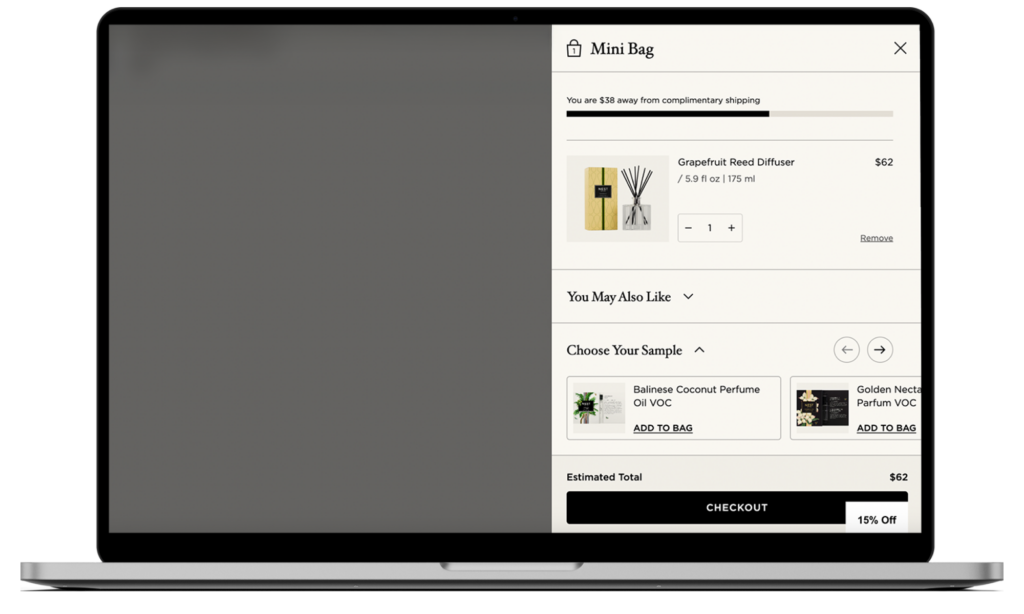
Personalized recommendations were added to Woodhouse Clothing‘s cart page to remind customers of the items that the shopper showed interest in but not yet added to cart. This has contributed to a 44% increase in conversion for the brand:
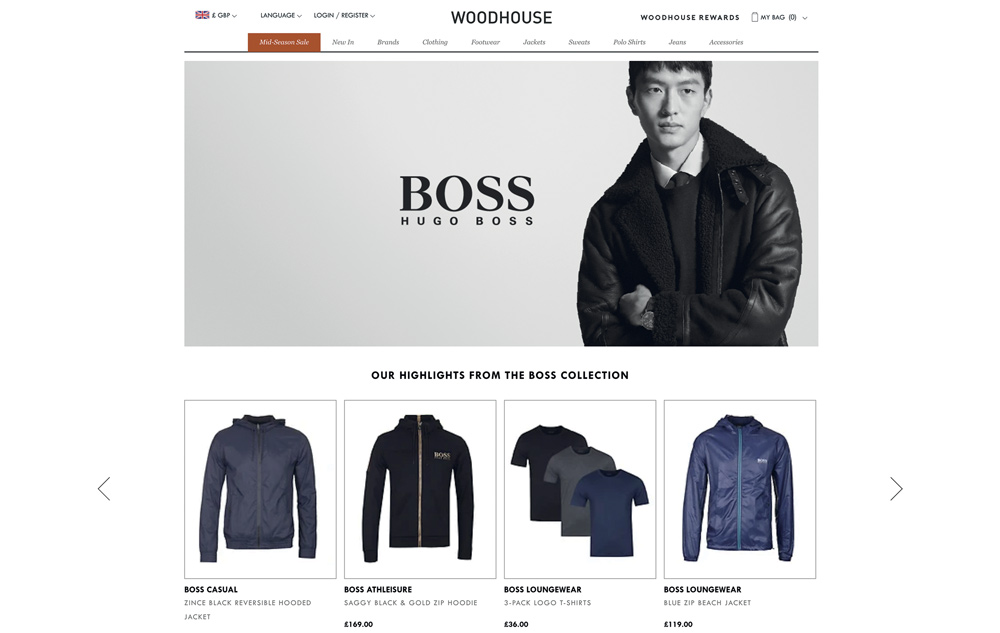
The Beer Hawk team set up an A/B test to measure how recommendations are tied to actual customer behavior on their cart page:
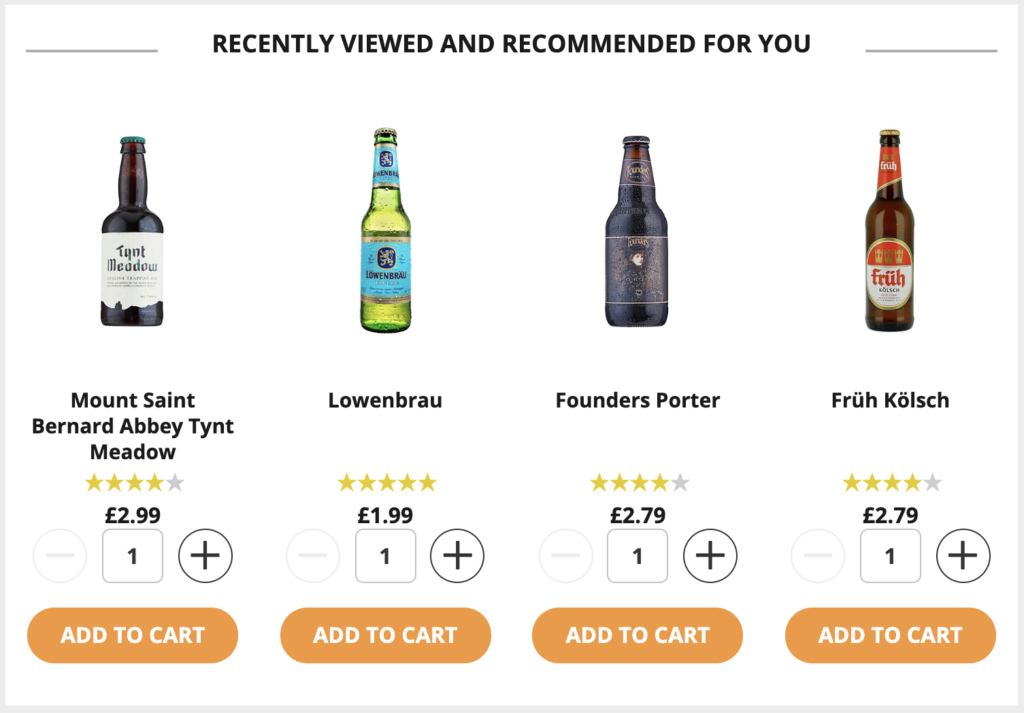
Sephora uses product recommendations on their checkout page to trigger up-sell opportunities:
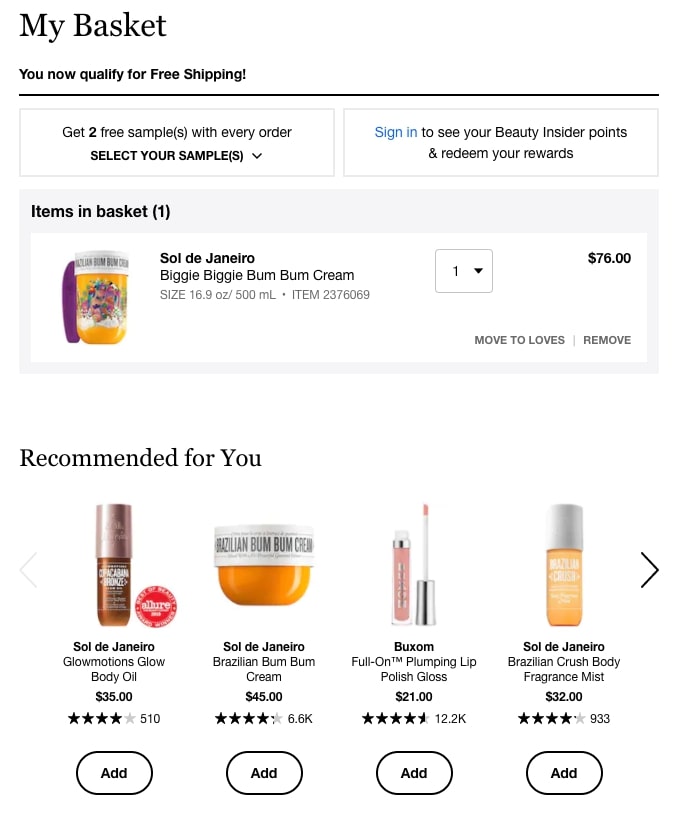
Le Tanneur displays items often bought with the items currently in a shopper’s cart on the cart page. These recommendations give shoppers one last chance to add complementary items to their cart and naturally drive average order value up.
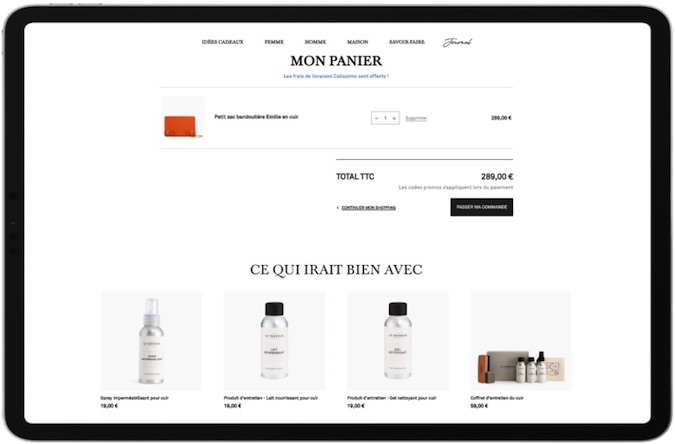
Shopping cart recommendations by LeSportsac include ‘collaboration’ and ‘exclusive’ tags to improve click-through rate:
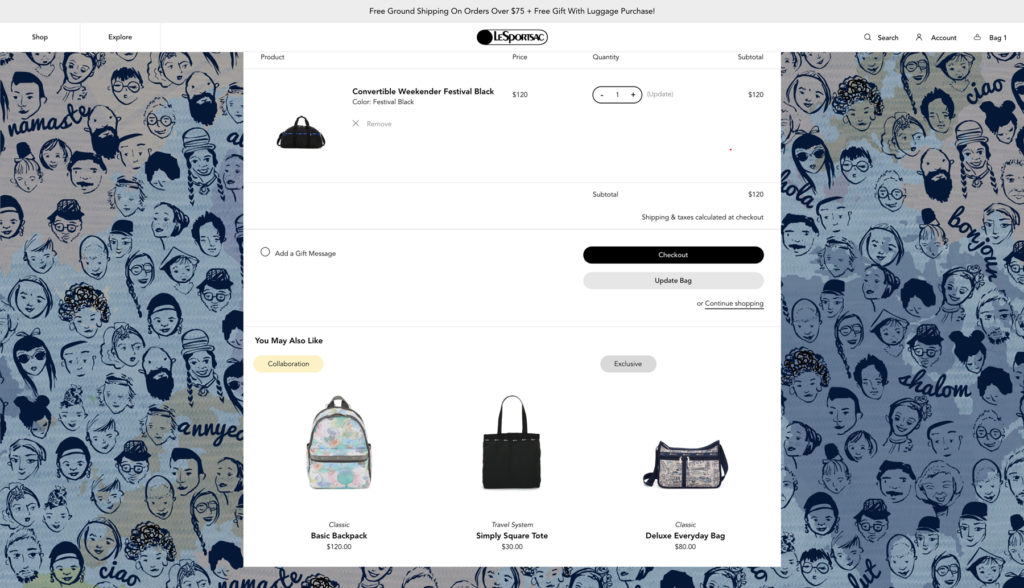
6. Checkout Page
Jewelry brand, Jenny Bird, used Nosto’s Recommendation Extensions to apply cart-related Product Recommendations on the checkout page.
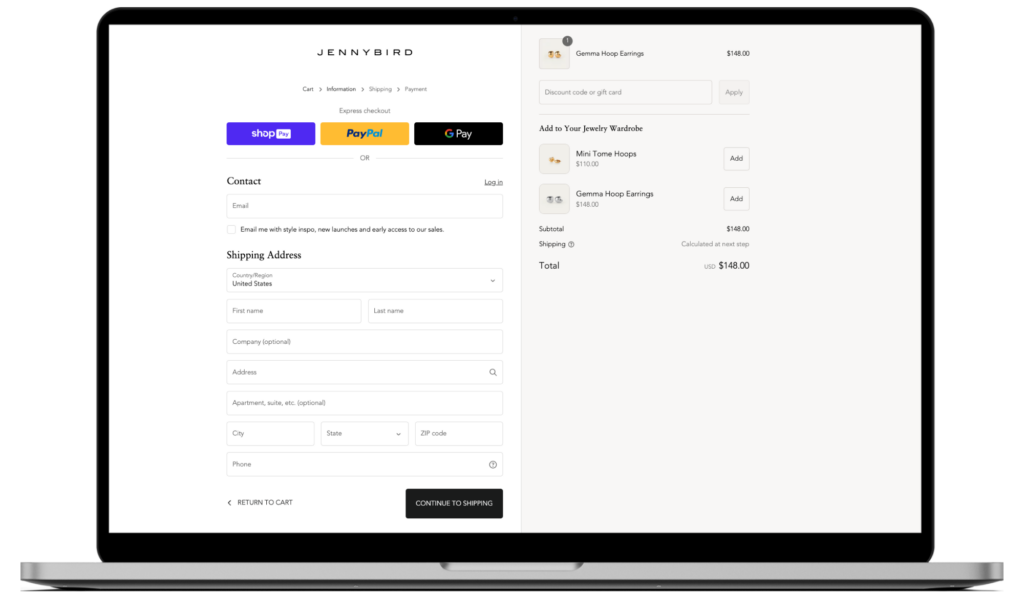
Luxury womenswear brand, Brochu Walker, used Nosto’s Recommendation Extensions to apply two variations of Product Recommendations on the checkout pages.
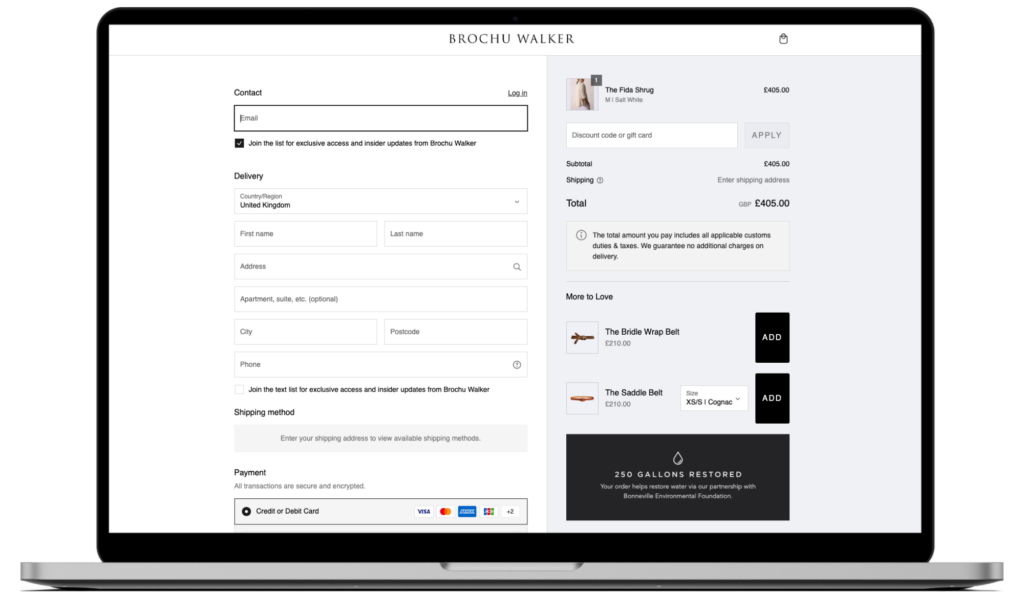
To increase AOV at the end of the purchase journey, The WOD Life integrated a product recommendation block ‘Still interested in these’ into their mini cart, showing the visitor’s browsing history.
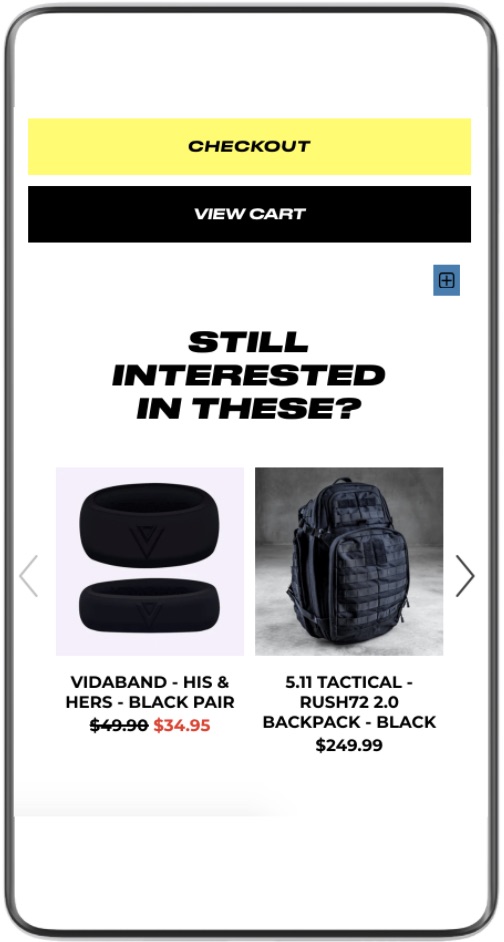
7. 404 Pages
Turn a dead end into a key part of your product recommendation strategy by leading a shopper back into product detail pages that are of interest to them. Using ‘previously viewed’ and ‘popular items’ recommendations on your 404 page can help turn a bad experience into one of discovery.
404 page recommendations can be as simple as the ones in the example below:
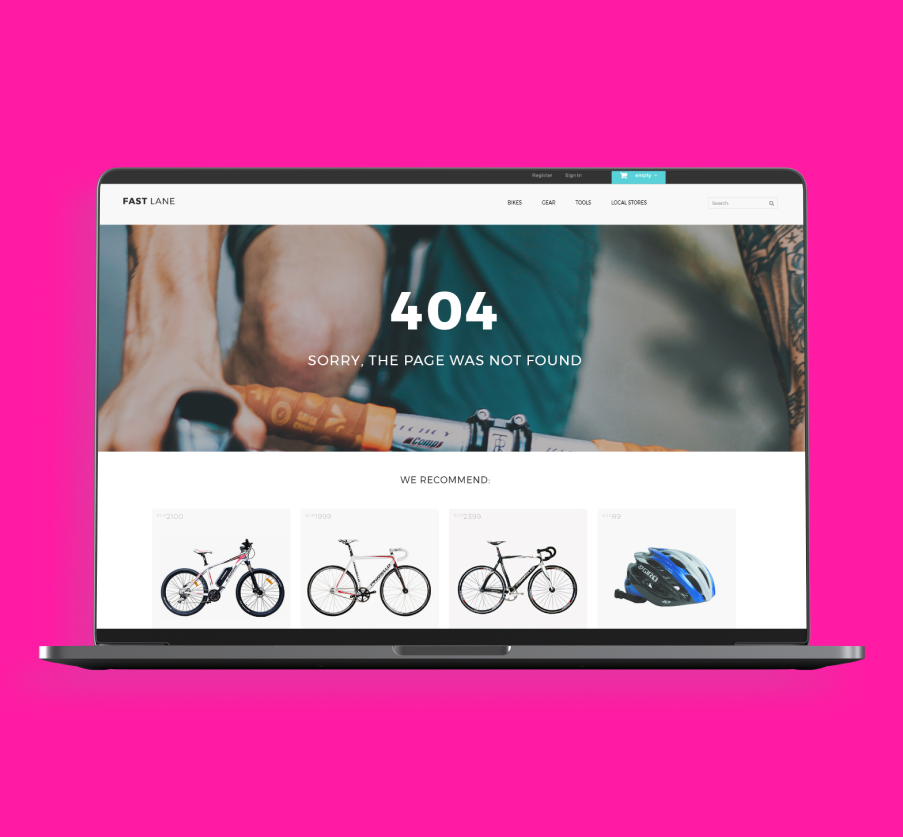
Chances are, if someone is accessing the site from an expired link, you won’t have browsing history data to be able to populate a personalized recommendation. However, using fallbacks to overcome this issue, and best-sellers are a good place to start:
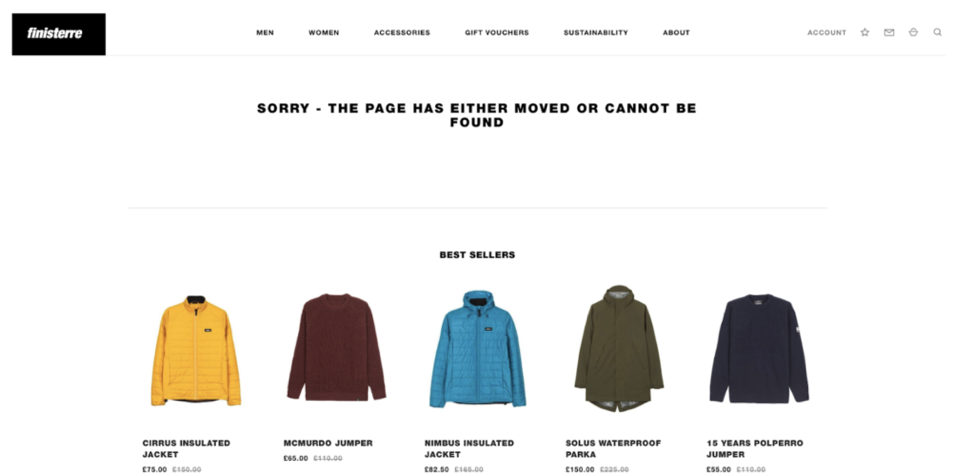
Best sellers can also be featured to drive the shopper towards products that are most likely to increase conversion:
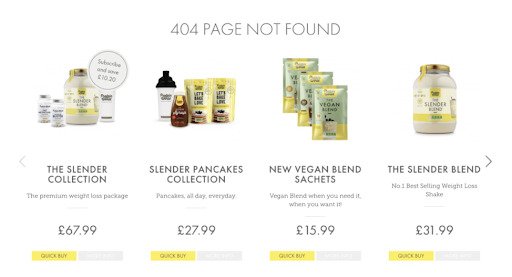
8. Pop-ups
With behavioral targeting options far more specific than ever before, the once shunned pop-up is now more relevant, more personal, and more effective for ecommerce brands. There are many ways to leverage a pop-up: from enticing hesitant shoppers with a time-limited discount to encouraging email capture to allow for further marketing. One especially useful way to make the most of a pop-up is to use them to display in-your-face product recommendations at the most crucial times.
If a shopper is about to exit your site, entice them with visitors with an exit pop-up including products they may have browsed or undiscovered items they may be interested in according to their browsing history.
Bare Minerals wanted to have a ‘welcome back’ message to previous visitors, highlighting items they’d previously added to cart, in addition to anything they’d heavily viewed before.
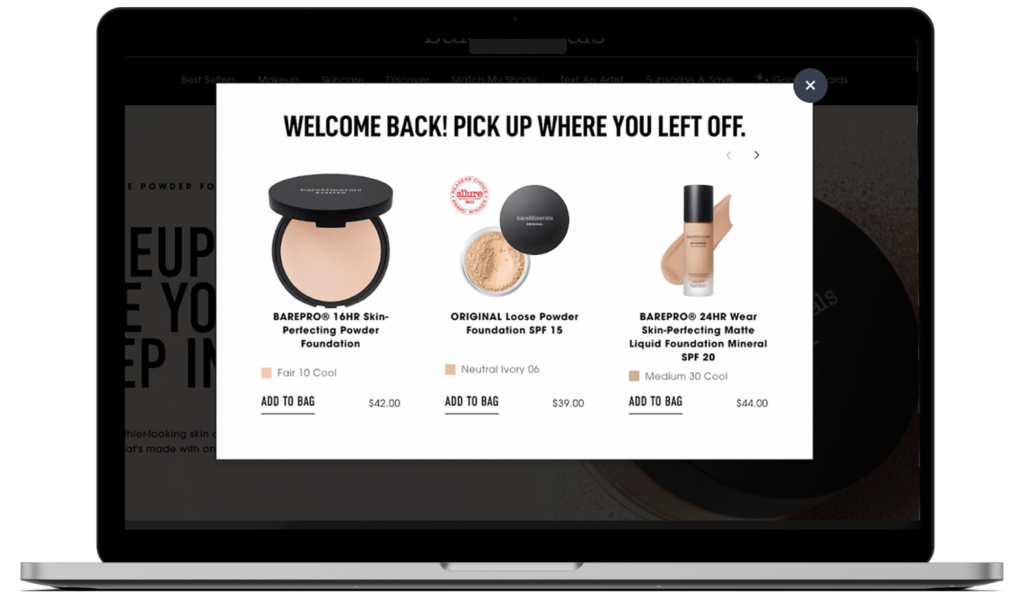
The WOD Life uses abandoned cart popups to re-engage visitors when they return to the site. A popup ‘Pick up where you left off’ shows the products left in cart to remind customers of their last site visit.
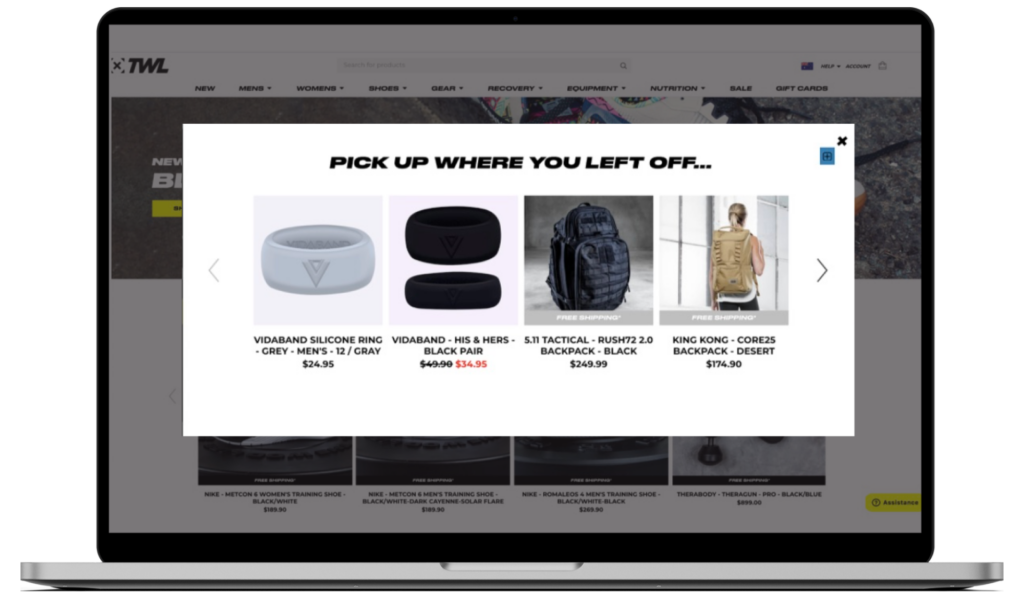
Using a combination of Recommendations and Pop-ups, and targeted towards the Returning Visitors lifecycle segment, Dermalogica greets returning visitors who haven’t yet made a purchase, showing a personalized recommendation with the two products they showed the most interest in on their last visit and are most likely to convert on.
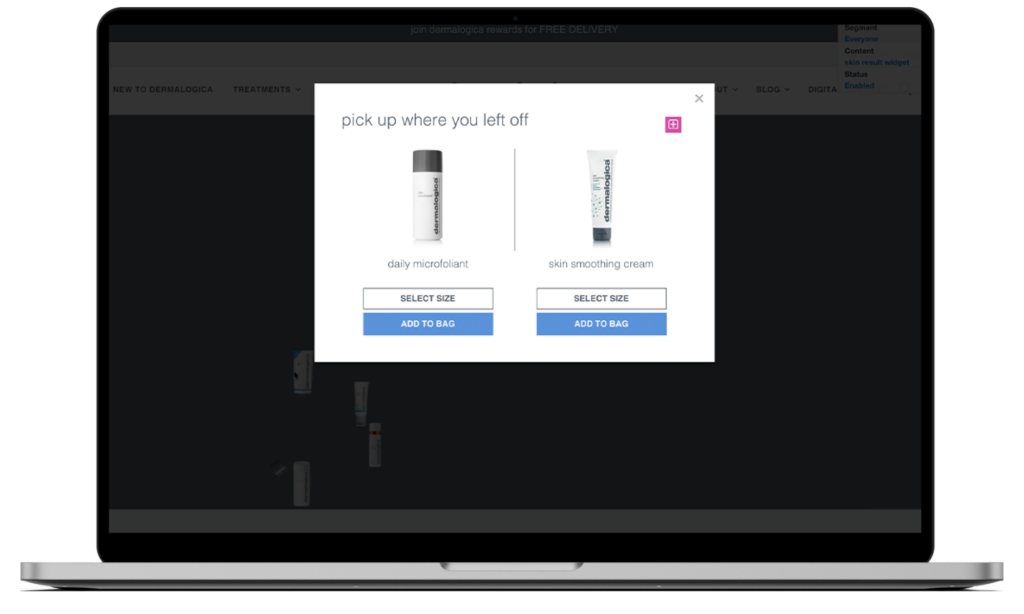
Want to learn more about the benefits of pop-ups? Explore additional ecommerce pop-up use cases you can use across your site.
9. Email Marketing
A well thought-out customer experience does not and after the shopper has left your site– whether they’ve left due to indecision or have already made a purchase. Instead, take advantage of other channels – like your email marketing strategy – by incorporating relevant recommendations that leverage behavioral cues. The result: more timely, relevant emails that increase engagement and lead customers back to your site.
Draw shoppers back to your store with product recommendations based on their previous shopping behavior. These recommendations can be seamlessly integrated into your email templates:
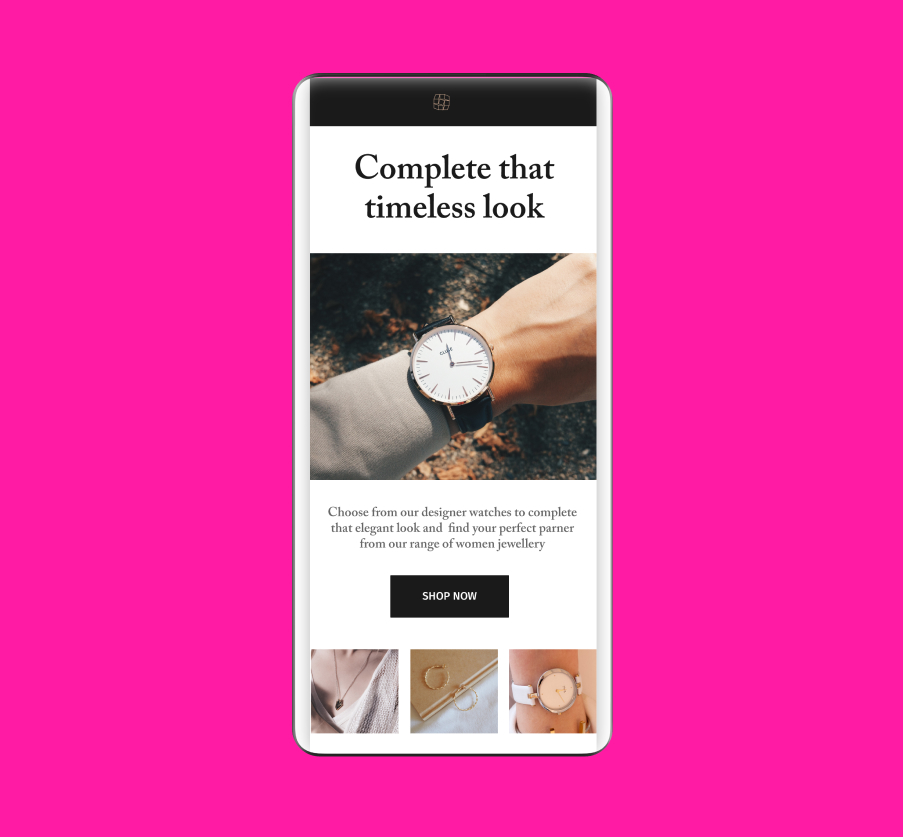
By combining Nosto’s email widgets with Klaviyo, Show Me Your Mumu curated custom emails based on browsing history and product affinity, seamlessly integrating them into site abandonment flows.
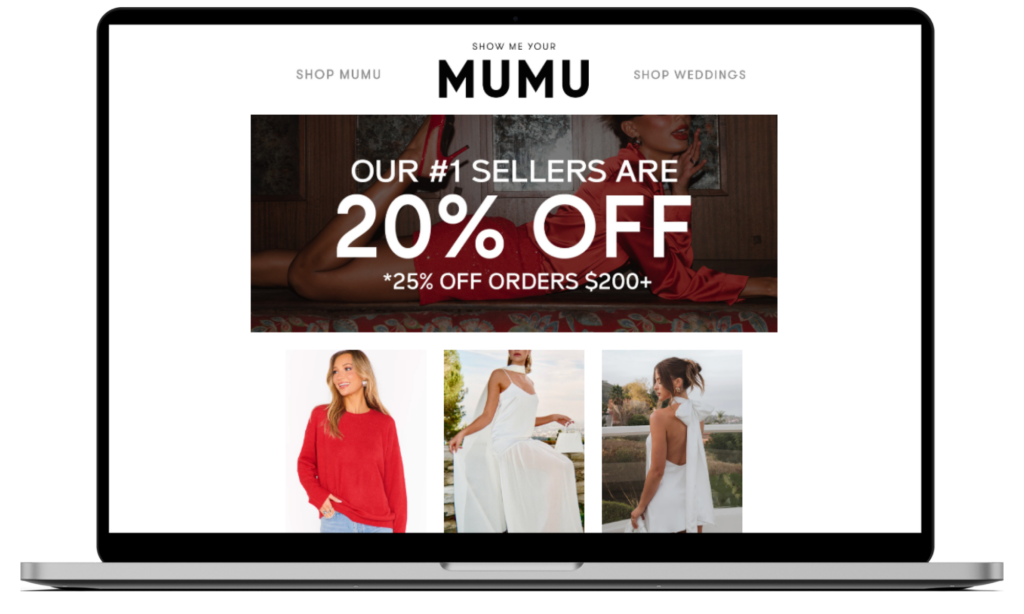
Ogee can automatically display Nosto-powered product recommendations in abandoned cart emails sent to visitors. These recommendations are personalized based on the products that Nosto’s data reveals shoppers left in their carts before exiting.
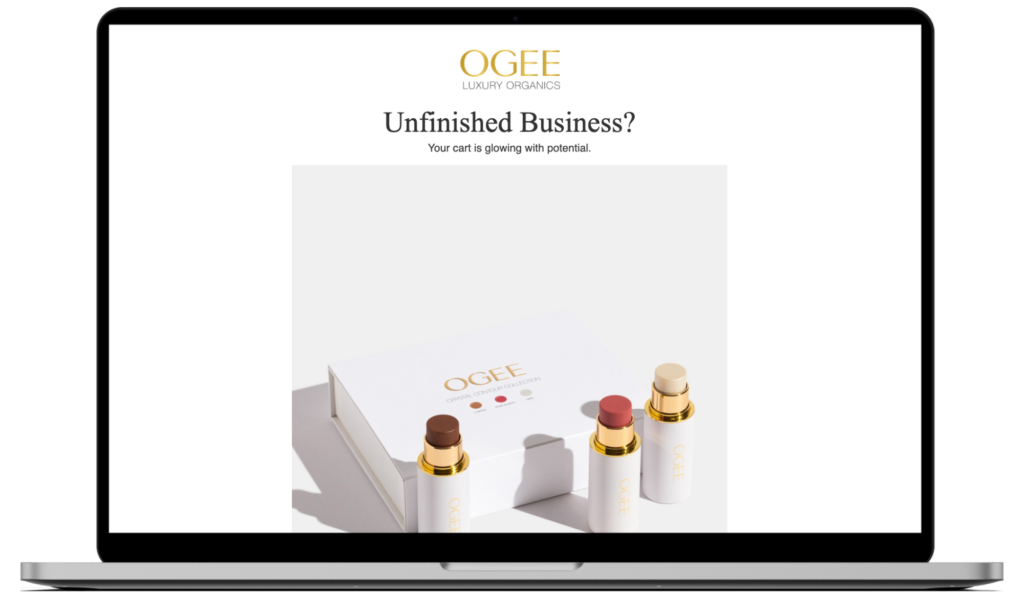
For Zoovillage, email is one of the brand’s most successful channels for ecommerce sales. The products displayed in their email campaigns are dynamic, meaning that they change according to shoppers’ previous behavior on the site, or show which products are trending on Zoovillage’s site at that current moment. This has led to a 15% increase in views on recommended products and a 20% increase in sales:
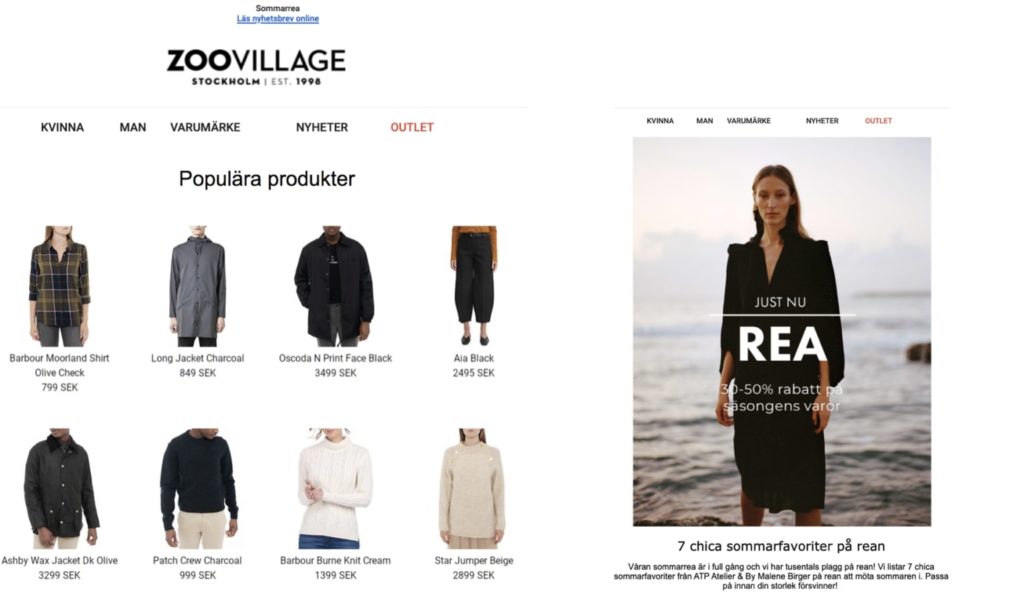
Get Started With These and Other Product Recommendation Examples
Getting started with product recommendations is fairly simple – and with the right tactics in place, you can completely transform the way customers interact with your brand, increase conversion and average order value and attract longtime customers. Nosto’s ecommerce experts are happy to help you get most out of your product recommendations and meet your specific business goals. Reach out to us today for a 1:1 chat and start setting up for the year ahead.

